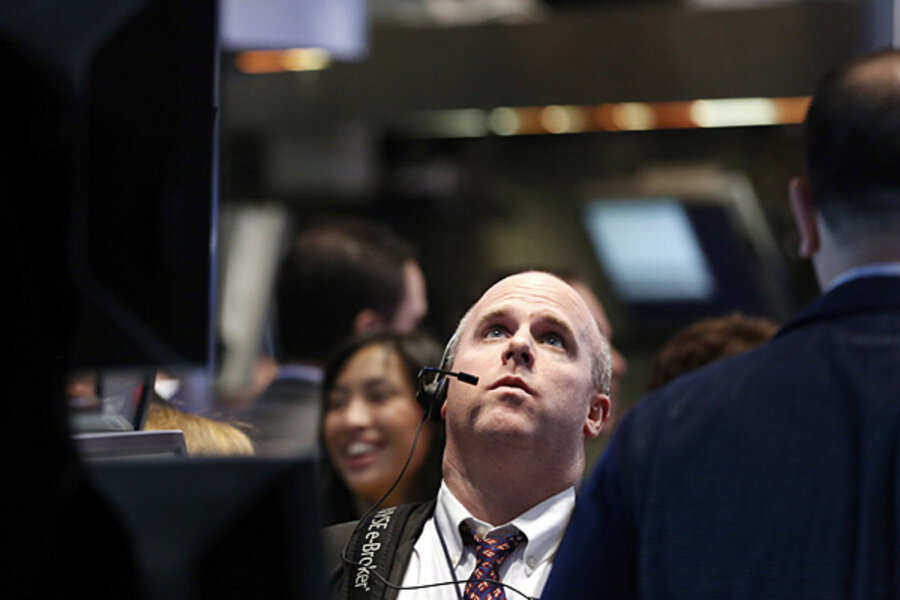Stocks edge higher; IBM pulls up Dow
Loading...
| New York
News that IBM will buy back more stock and raise its dividend helped pull major stock indexes out of a morning slump Tuesday.
IBM and other tech stocks led the Standard & Poor's 500 index up. The broad-market measure ended April with a 1.8 percent gain, the sixth month in a row the index has climbed higher.
Worries about slower economic growth have rattled the stock market this month, but it has consistently bounced back. Brad Sorensen, director of market research at the brokerage Charles Schwab, said that's a result of investors having few alternatives.
"Right now it seems like every pullback in the market is seen as a buying opportunity," Sorensen said. "People may say they're getting nervous, but where else are you going to put money at this point? Into Europe with their political issues? Into Treasurys paying less than 1.7 percent?"
The S&P 500 edged up 3.96 points to close at 1,597.57. The slight gain of 0.3 percent pushed the index to an all-time high for the second day straight.
A report of another record high in European unemployment helped drive money into U.S. government debt, briefly sending the yield on the benchmark 10-year Treasury note to lowest level of the year, 1.65 percent.
IBM said it will add a dime to its quarterly dividend and buy back up to $5 billion more of its own stock. Earlier this month, the company surprised investors when it reported a drop in quarterly earnings and sales. IBM's stock rose $3.39 to $202.54.
The tech giant's 1.7 percent gain tugged the Dow Jones industrial average up. The Dow fell as much as 84 points in morning trading but ended with a gain of 21.05 points at 14,839.80. That's an increase of 0.1 percent.
The S&P has now climbed for six months in a row. That's the longest stretch of gains since a seven-month run that started in March 2009, when the market hit a financial crisis low, and ended in October 2009.
This earnings season has delivered investors a mixed bag of news. More than half of the companies in the S&P 500 have turned in results, and seven of 10 have beaten analysts' estimates for earnings, according to S&P Capital IQ. Nearly as many, however, have come up short on revenue: Six of 10 have missed analysts' revenue targets. That suggests companies are getting more of their profits from laying off staff and other cost-cutting efforts instead of from higher sales.
The Dow and the S&P 500 ended the month with gains of 1.8 percent. It wasn't exactly a smooth ride. The two indexes reached record highs in the second week of April, then took a steep fall in the next. News that China, the world's second-largest economy, slowed unexpectedly pummeled the prices of oil, copper and other commodities. The stock market had its worst day of the year on April 15, when the S&P 500 lost 2.3 percent.
In other trading, the Nasdaq composite index rose 21.77 points to 3,328.79, up 0.7 percent. The dollar fell against the yen and the euro, and the price of crude oil fell $1 to $93.46 a barrel. Gold edged up $4.70 to $1,472.10 an ounce.
The yield on the 10-year Treasury note traded at 1.67 percent late Tuesday, the same as the day before. In response to slower economic growth, bond traders from around the world have been buying Treasurys this month, driving yields down. The 10-year yield started April around 1.85 percent.
Among other stocks making big moves:
— Pfizer dropped 4 percent after the drug maker's results fell short of what analysts had expected. Falling sales of Lipitor, its cholesterol drug, crimped revenue. The world's second-largest drug maker also cut its profit forecast for the rest of the year. Pfizer lost $1.36 to $29.07
— Pitney Bowes sank 16 percent after the maker of mailing equipment and software cut its dividend in half and posted a 58 percent drop in net income. Pitney Bowes sank $2.53 to $13.67.
— Avon Products' quarterly loss wasn't as deep as analysts had expected. The direct-seller of cosmetics has been cutting staff and scaling back operations in an effort to turn around its business. Avon's stock rose 92 cents to $23.16, a gain of 4 percent.





